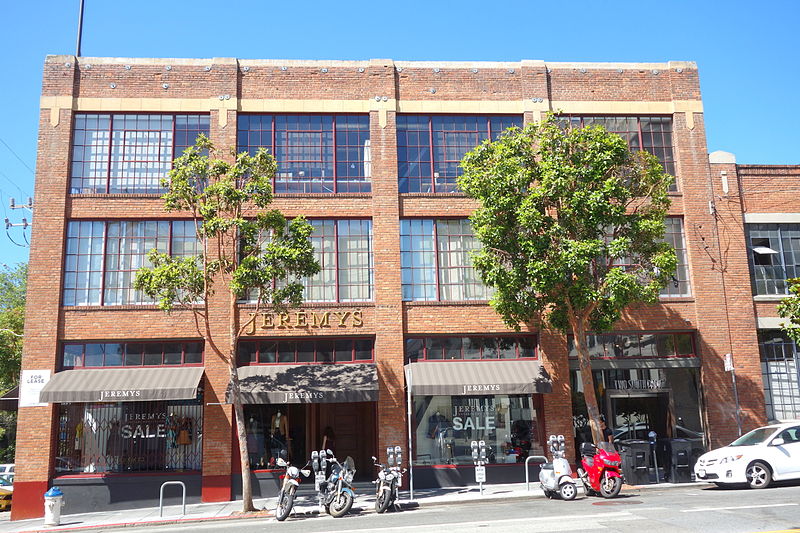New places better reflect what happens when language gets cut off from reality than San Francisco’s South Park, a motley patch of scruffy grass that briefly reigned as the village green of Dot.com Central.
In the late 1800s this was an elite address, the town’s first ‘planned community’ laid out around a two-block garden grid on the English model. After the invention of the cable car, which made it possible for the rich to live atop Nob Hill, and the earthquake of 1906, which burned South Park residences to the ground, the neighborhood fell off the social map. Until a few years ago this was a scary place, a district of seedy boarding houses, single-room-occupancy hotels and mechanic’s garages. Legend has it that ex-cons from Alacatraz would come here to spend their first nights of freedom, partaking of the pleasures they couldn’t get in prison. Even today, lots of locals are only vaguely aware that South Park exists; taxi drivers often need directions to get there.
With the arrival of the Internet, though, this area morphed into prime real estate. Wired magazine, Bible of the age of connectivity, was headquartered at one end of South Park; the venture capitalists who launched Napster at the other. With abundant loft space and few long-term leases to displace, dot.comers took over. They arrived dressed de rigeur in black, pockets stuffed with cash. A peeling billboard captures the spirit of the era. “Wanted, Technology Heroes” proclaims the headline, over a picture of a half-dozen ethnically diverse, buff, steely-eyed young men and women (none older than twenty-five, one with a lovable small dog in his arms) all wearing the t-shirt of the company seeking employees. No hint of self-doubt or irony in this image, only the smug certainty of the anointed and elect, confidently possessing the keys to the kingdom.
Rents on South Park soared, from maybe $5 a square foot to as high as $100, as demand seemed insatiable for dot.com work lofts. Prices rivaled Manhattan. A dumpy two-story frame structure, shingles peeling, went on the market for multiple millions. Small-scale businesses that had lasted for decades now disappeared, unable to compete for space with cash-rich start-ups. Stories of irrational displacement abounded: a thriving restaurant with devoted clientele, commercial design studios, decades-old retail outlets. As the park bustled with hyper-activity, the owner of one of the few well-maintained houses on the park routinely received unsolicited offers in his mail box to rent a spacious second-floor apartment for ten thousand dollars a month. Everybody had a scheme.
Now, nearly every building bears a For Lease sign, the restaurant remains vacant, the dilapidated building is still for sale. Two commercial projects have been halted midstream, reminding a visitor of Third World construction sites. The homeless have re-claimed the park.
To a grizzled veteran of South Park, the coming-and-going of the dot.comers is little more than the latest blip on the screen. “The place is always in transition,” he says. “Used to be cars getting their batteries boosted.” A one-time commercial photographer who was among the first shooters of the fabled Marlboro Man cowboy images, Ed Zack has been buying up real estate here since he first showed up on New Year’s Eve forty years ago. Something of an eccentric, he spends his days sitting propped against the open door of the building where he lives, smoking cigarillos, surveying doings on the Park where he reigns as de facto mayor. He loves it here, his “urban forest” with its fog-free micro-climate. “When I think about moving, I can’t imagine anywhere else I’d want to live.”
Zack is a laconic man, but he conveys a vivid sense that South Park represents something considerably grander than “boomers in their Beemers.” To him this modest oval green embodies an oasis of opportunity. Rooms for Rent signs represent opportunities. And he resonates to the latent possibilities of a landscape where the rules are yet to be written. More conventional middle-class types might shudder at what they take to be the unruly presence of drunks and drifters; but Zack revels in the social diversity of a locale where independent-spirited entrepreneurs, artisans, and mechanics could once set up shop on a shoe-string in a city not renowned for supporting small business. With the bursting of the dot.com bubble, it may return to its earlier scale.
The contours of South Park are being shaped by this residual tension between an haut bourgeois life-style of conspicuous consumption financed by easy money and a more earthy proletarian model (as can flourish only in a place like San Francisco, where the birthday of radical labor leader Harry Bridges continues to be the occasion of an annual parade). The unfolding of this dialogue in South Park constitutes a particularly rich specimen study of how social expectations get shaped and then dismissed.
Internet mania understandably feels like ancient history in the wake of September 11, but the abrupt rise-and-fall of South Park is a tale worth considering because of what it reveals about how American culture operates. The particular content of the message changes but the rhetorical strategies at play in shaping mass enthusiasm for speculative investment are not so unlike, say, those used to engender war fervor.
The trail leads back to language and its grounding (or lack thereof) in the material world of cause-and-effect.
One of the principal high tech venture capitalists in town now admits how delusional and self-serving language became in the midst of the bubble. John Hummer, arguably the tallest VC in the trade (he played pro basketball after graduating Princeton in 1969, then got a M.B.A. at Stanford), has been in the business of funding start-ups for two decades (he was the original investor in the company that invented voice mail). The partnership he formed in 1989 with Anne Winblad (one-time girlfriend of Bill Gates, himself a limited partner in Hummer Winblad) ranks among top-tier firms with a portfolio on their web page that lists dozens and dozens of companies. This is no fresh-faced ingénue talking.
“The vast scale of the Internet made people believe that ‘this time the rules are different,'” he says. “I like to say that all of Silicon Valley needs psychiatric therapy because we really believed that wealth could be created without profits.” Greed ran rampant: “you had to be a person of strong constitution and character to stand fast when you watched companies with no valid business model go public with valuations in billions.” But Hummer also sees another factor at play. “We changed our language.” Fueling the hysteria was the suspension of conventional analysis for a promoters’ lexicon of promise. “We weren’t talking about profitability, gross margins, growth of licenses, etc., but instead things that now seem laughable—eyeballs, hits, time spent per page.”
This language had social implications. The “new metrics” were, ultimately, about captive audiences and mind control. Dot.coms were hyped on their potential to erect a barricade around their visitors, turn them into proprietary clients to be passed along to others who paid for the right to have a hot-link on the original site (think of AOL and its exclusive “key words”). In theory (and in IPO prospectus) these sites might present themselves as conventional vendors of goods or media, but in practice they were offering seats in a world-wide web game of musical-chairs where “the next stop” was the next cash transaction. “We no longer thought about creating lasting value,” acknowledges Hummer. “Everything was about immediate wealth creation,” and following the classic pattern of hype, immediate wealth came by selling the rights to the possibility of getting a piece of somebody else’s “lasting value” downstream. Not that a conscious pyramid scheme was being designed, but the new language of value, ethereal and prophetic, downplayed risk and was tailored, in the parlance of Wall Street cynicism, to appeal to a succession of ‘greater fools’ who kept buying in until someone ended up caught without a place when the music stopped.
The linguistic logic of the dot.com bubble was expressed in a particularly Californian idiom. San Francisco and the Bay Area, long accustomed to perceiving the social order through its own singular prism, is one of several places in the country where every few decades a new American cultural ethos has been defined, starting with the gold rush mentality of the nineteenth century (“go west, young man”). In the 1960s this was the breeding ground of hippies, psychedelics, and the human potential movement. In the 1970s it spawned second-wave feminism and gay liberation. In the mid-1980s Alice Waters at Chez Panisse and her cohorts reformulated regional cuisine into gourmet fare and launched the national ‘foodie’ craze. And it was here, centered around South Park, that the Internet first shifted from technology to lifestyle.
When west-coast fashions spread to the east, authority typically gets called into question. Long-standing protocols are undermined while personal liberation is celebrated. Generally this entitlement is legitimated on the basis of specialized knowledge (e.g., how to write HTML web code), a vision of utopian social transformation, or perhaps a mystical kinship with nature. The showdown pits ‘suits’ against ‘geeks.’ The old order, perceiving itself under siege as waves of fervor swell, seeks to co-opt the threat by pretending to ‘get it’ (like the Fortune 100 CEO’s who no longer wear neckties).
The claims of the new evangelists, however, invariably prove overstated. Disappointment ensues, then backlash. The metaphors and key messages of the culture correspondingly change. The language of allusion and open-ended metaphor turns literal and concrete: ‘Peace and Love’ becomes ‘Just Say No’; grilled red wine-marinated quail withsugo di salsicce and stone ground polenta becomes take-out Boston Chicken and mashed potatoes; ‘dot.com’ becomes ‘dot.bomb’.
And South Park, no longer populated by ‘technology heroes’ eager to work 24/7 to change the world, recedes back into its past. While Ed Zack’s next generation of grease-smeared artisans waits in the wings.








